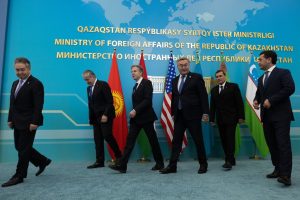This week, U.S. Secretary of State Antony Blinken swept through Central Asia — stopping in Kazakhstan and Uzbekistan — with promises of sustained support and new aid for the region wedged between Russia and China and geopolitically hemmed in amid the war in Ukraine.
During the trip, Blinken participated in a C5+1 meeting in Astana with the region’s foreign ministers, in addition to bilateral meetings with each foreign minister. He also met with the Kazakh and Uzbek presidents.
The year-long Russian war in Ukraine provided the thematic backdrop for the trip in a way the U.S. war in Afghanistan once did. This illuminates as much as it obscures. By that I mean, it pulls to the front the complex geopolitical dynamics at play while shading both domestic realities and specific bilateral issues that invariably interact with those dynamics.
During remarks to the press in Uzbekistan, before a question and answer session, Blinken commented that “few regions have been more acutely affected [by the war in Ukraine] than Central Asia, including Uzbekistan, where people continue to shoulder increased food and energy prices.” Blinken touched on the deep concerns in Central Asia regarding the invasion: “…if a powerful country is willing to try to erase the borders of a sovereign neighbor by force, what’s to stop it from doing the same to others? Countries across Central Asia understand this.”
Washington’s mantra for the region — U.S. support for the region’s sovereignty, territorial integrity, and independence — harkens back to the Trump administration’s Central Asia policy, unveiled in February 2020, which sought to carry U.S. engagement with the region beyond Afghanistan at last. This framing has come more sharply into focus under the Biden administration. The United States sees Central Asia as a region bordered by an “immediate threat to the free and open international system” and “the only competitor with both the intent to reshape the international order and, increasingly, the economic, diplomatic, military, and technological power to advance that objective” — Russia and China, respectively, as stated in the 2022 U.S. National Security Strategy.
In each of his meetings and statements, Blinken reiterated U.S. commitment to the region’s sovereignty, territorial integrity, and independence and contrasted that with Russian efforts in Ukraine. During a March 1 press briefing, Blinken acknowledged the region’s geopolitical complexities and outlined the ways in which the challenges faced by the region as a consequence of the war in Ukraine — higher food prices and the secondary effects of sanctions on Russia, for example — are the direct results of Russian actions.
The United States, he said, was working closely with regional governments to help them understand the sanctions and “as necessary, looking to see what we can do to mitigate the negative effects that they’re feeling.” More specifically, he said this included issuing licenses for trade and investments in helping the region diversify its trade relationships.
The day before in Astana, during a press conference held alongside Kazakh Foreign Minister Mukhtar Tileuberdi, Blinken responded to a question regarding the possibility of secondary sanctions on Kazakhstan and the spillover effects of sanctions on Russia in the region by noting the context: That sanctions don’t “materialize out of thin air” but rather in response to Russian actions. He noted that licenses had been granted “for companies or entities in countries that are engaged with sanctioned Russian companies so that they have time to wind down those activities and cut their ties with Russia.”
Tileuberdi added after Blinken had concluded his answer that the United States and Kazakhstan were in regular consultations “in order to avoid the negative consequences for the economy of Kazakhstan and in order to prevent a possible secondary sanctions.” He continued, stating that “we are really thankful to the American side for informing us about possible cases of the imposition of secondary sanctions as early as possible.”
Blinken also pointed to the announced additional funds being allocated for the Economic Resilience Initiative in Central Asia (ERICEN).
Last year, the United States unveiled ERICEN — a $25 million commitment in fiscal year 2022 — “to catalyze transformative economic growth across Central Asia in the wake of Russia’s unprovoked war of aggression in Ukraine.” The funding, per a U.S. State Department factsheet, was provided to “diversify trade routes, expand investment in the region, and increase employment opportunities by providing the populations of Central Asia with practical skills for a modern job market.” The U.S. intends to add $20 million this year in addition to “$5 million to support regional connectivity through economic and energy programs.”
These are not massive sums when contrasted with the volume of trade between Russia, China, and the region, and government press releases are light on details about the ERICEN’s programs.
If nothing else, Blinken’s trip through Central Asa underscored that the region remains very much in the messy middle, but that’s not necessarily a bad position to be in. Russian, Chinese, European, and U.S. diplomats have trod well-worn paths through the region, especially in the past year, and Central Asian capitals have kept their doors open.

































